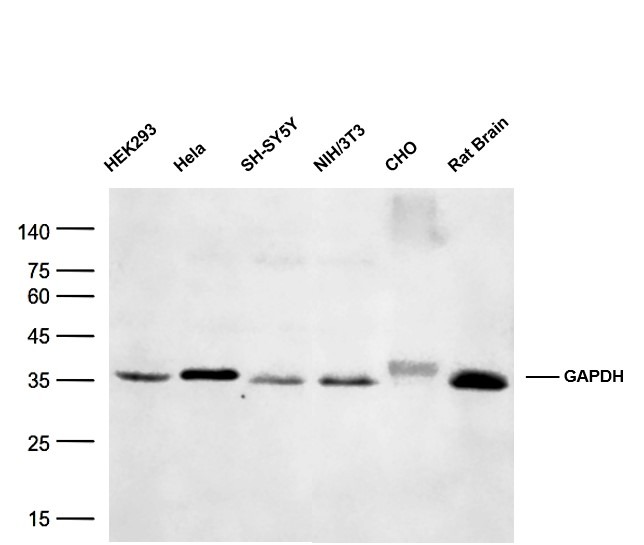Shopping Cart
Remove All Your shopping cart is currently empty
Your shopping cart is currently empty
GAPDH Loading Control Antibody (9U185) is a Mouse antibody targeting GAPDH Loading Control. GAPDH Loading Control Antibody (9U185) can be used in WB.
| Pack Size | Price | USA Warehouse | Global Warehouse | Quantity |
|---|---|---|---|---|
| 50 μL | $125 | 7-10 days | 7-10 days | |
| 100 μL | $184 | 7-10 days | 7-10 days | |
| 500 μL | $755 | 7-10 days | 7-10 days |
| Description | GAPDH Loading Control Antibody (9U185) is a Mouse antibody targeting GAPDH Loading Control. GAPDH Loading Control Antibody (9U185) can be used in WB. |
| Synonyms | HEL-S-162eP, glyceraldehyde-3-phosphate dehydrogenase, GAPD, G3PD |
| Ig Type | IgG |
| Clone | 9U185 |
| Reactivity | Human,Mouse,Rat,Hamster (predicted:Chicken,Dog,Pig,Rabbit,Sheep,Monkey) |
| Verified Activity | 1. Sample: Lane 1: Human HEK293 cell lysates Lane 2: Human Hela cell lysates Lane 3: Human SH-SY5Y cell lysates Lane 4: Mouse NIH/3T3 cell lysates Lane 5: Hamster CHO cell lysates Lane 6: Rat Brain tissue lysates Primary: Anti-GAPDH (TMAB-00741) at 1/200000 dilution Secondary: IRDye800CW Goat Anti-Mouse IgG at 1/20000 dilution Predicted band size: 38 kDa Observed band size: 38 kDa 2. Sample: Lane 1: Rat Cerebrum tissue lysates Lane 2: Rat Heart tissue lysates Lane 3: Human A549 cell lysates Lane 4: Human Jurkat cell lysates Lane 5: Human Huvec cell lysates Lane 6: Human Hela cell lysates Lane 7: Human U2os cell lysates Lane 8: Human HepG2 cell lysates Primary: Anti-GAPDH (TMAB-00741) at 1/50000 dilution Secondary: IRDye800CW Goat Anti-Mouse IgG at 1/20000 dilution Predicted band size: 38 kDa Observed band size: 38 kDa   |
| Application | |
| Recommended Dose | WB: 1:5000-500000 |
| Antibody Type | Monoclonal |
| Host Species | Mouse |
| Subcellular Localization | Cytoplasm, cytosol. Nucleus. Cytoplasm, perinuclear region. Membrane. Note=Translocates to the nucleus following S-nitrosylation and interaction with SIAH1, which contains a nuclear localization signal. Postnuclear and Perinuclear regions. |
| Construction | Hybridoma Monoclonal Antibody |
| Purification | Protein G purified |
| Appearance | Liquid |
| Formulation | 0.01M TBS (pH7.4) with 1% BSA, 0.02% Proclin300 and 50% Glycerol. |
| Concentration | 1 mg/mL |
| Research Background | oading Control Glyceraldehyde 3 phosphate dehydrogenase (GAPDH) is well known as one of the key enzymes involved in glycolysis. As well as functioning as a glycolytic enzyme in cytoplasm, recent evidence suggests that mammalian GAPDH is also involved in a great number of intracellular proceses such as membrane fusion, microtubule bundling, phosphotransferase activity, nuclear RNA export, DNA replication, and DNA repair. During the last decade a lot of data appeared concerning the role of GAPDH in different pathologies including prostate cancer progression, programmed neuronal cell death, age related neuronal diseases, such as Alzheimer's and Huntington's disease. GAPDH is expressed in all cells. It is constitutively expressed in almost all tissues at high levels. There are however some physiological factors such as hypoxia and diabetes that increase GAPDH expression in certain cell types. GAPDH molecule is composed of four 36kDa subunits. |
| Immunogen | Recombinded Human GAPDH |
| Antigen Species | Human |
| Gene Name | GAPDH |
| Gene ID | |
| Protein Name | Glyceraldehyde-3-phosphate dehydrogenase |
| Uniprot ID | |
| Biology Area | Energy Metabolism,Huntington's disease,Alzheimer's disease,Neurodegenerative disease,Cancer,Energy Metabolism,Carbohydrate metabolism,GAPDH,Metabolism of carbohydrates |
| Function | Has both glyceraldehyde-3-phosphate dehydrogenase and nitrosylase activities, thereby playing a role in glycolysis and nuclear functions, respectively (PubMed:3170585, PubMed:11724794).Glyceraldehyde-3-phosphate dehydrogenase is a key enzyme in glycolysis that catalyzes the first step of the pathway by converting D-glyceraldehyde 3-phosphate (G3P) into 3-phospho-D-glyceroyl phosphate (PubMed:3170585, PubMed:11724794).Modulates the organization and assembly of the cytoskeleton (By similarity).Facilitates the CHP1-dependent microtubule and membrane associations through its ability to stimulate the binding of CHP1 to microtubules (By similarity).Component of the GAIT (gamma interferon-activated inhibitor of translation) complex which mediates interferon-gamma-induced transcript-selective translation inhibition in inflammation processes (PubMed:23071094).Upon interferon-gamma treatment assembles into the GAIT complex which binds to stem loop-containing GAIT elements in the 3'-UTR of diverse inflammatory mRNAs (such as ceruplasmin) and suppresses their translation (PubMed:23071094).Also plays a role in innate immunity by promoting TNF-induced NF-kappa-B activation and type I interferon production, via interaction with TRAF2 and TRAF3, respectively (PubMed:23332158, PubMed:27387501).Participates in nuclear events including transcription, RNA transport, DNA replication and apoptosis (By similarity).Nuclear functions are probably due to the nitrosylase activity that mediates cysteine S-nitrosylation of nuclear target proteins such as SIRT1, HDAC2 and PRKDC (By similarity). |
| Molecular Weight | Theoretical: 38 kDa. |
| Stability & Storage | Store at -20°C or -80°C for 12 months. Avoid repeated freeze-thaw cycles. |
| Transport | Shipping with blue ice. |
| Size | Quantity | Unit Price | Amount | Operation |
|---|

Copyright © 2015-2025 TargetMol Chemicals Inc. All Rights Reserved.